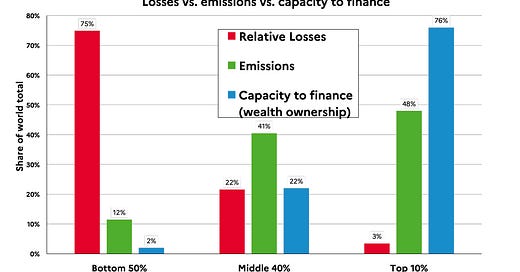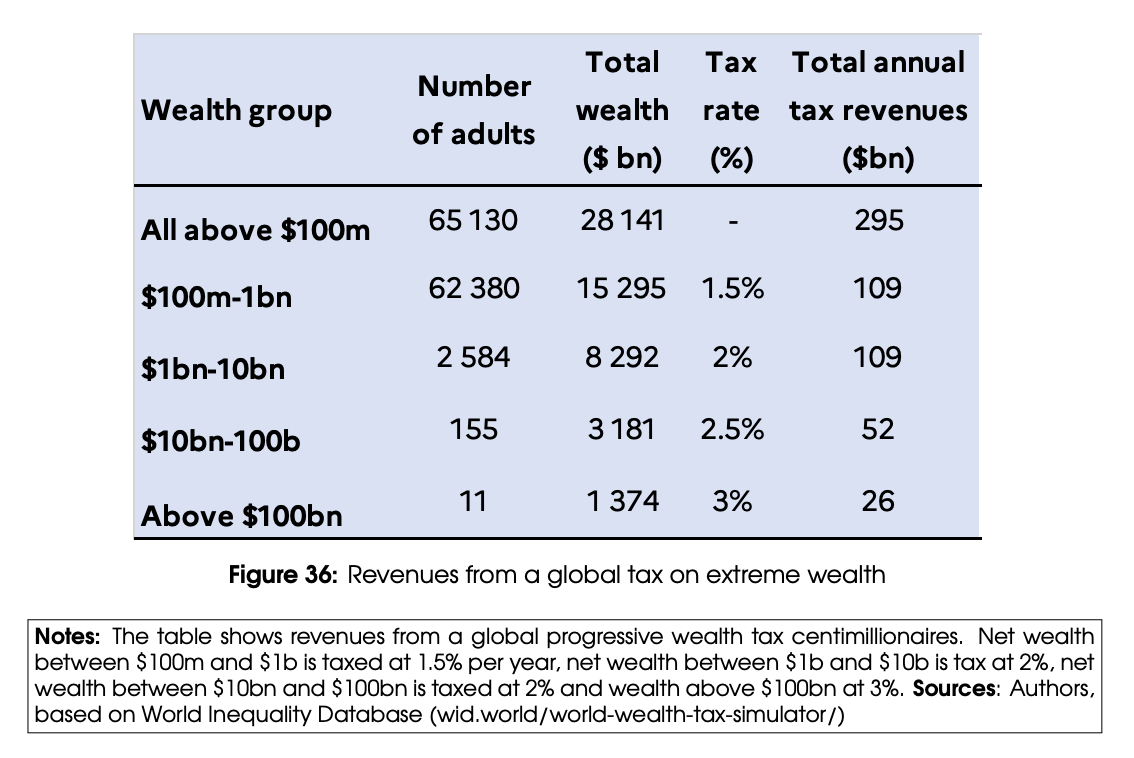The climate crisis is often discussed as a global problem which requires a collective mobilization of humanity. This can be inspiring. Against the backdrop of the fraught geopolitics of today, it can even be comforting to imagine that there are at least some problems that “we” have in common. As is brought out by the Climate Inequality Report 2023, authored by the team of Lucas Chancel, Philipp Bothe, and Tancrède Voituriez, this “global” vision of the problem is profoundly misleading.
The reality of the “global climate problem” is, in fact, defined by a triple inequality. The impact is suffered most by those who have least contributed to the crisis and are least able to pay. Those of us who are most responsible and have most ability to contribute to the solution, currently suffer and are threatened in the future with relatively less impact.
The juxtaposition of the three dimensions of the climate problem is stark and should orientate all future debate.
***
The driver of the climate change is not humanity in general, but those who have benefited from substantial economic development, around the world and across national borders. Globally, 89 percent of emissions are due to the 4 billion people in the top half of the global income distribution. 48 percent are due to the 800 million people in the top ten percent of the income distribution. 17 percent of all emissions are generated by the top one percent alone - 80 million people. Within the top one percent, there are further upward gradations.
Source: Climate Inequality Report 2023
Since the 1990s, the distribution of CO2 emissions has tracked global inequality trends, as charted, for instance, by Branko Milanović. In 1990 the problem of climate justice was, in large part, one of between-country inequality. 62 percent of carbon inequality was down to the gap between rich country and poor country emissions. This reflected the polarization of the world economy at the time.
Today, almost two thirds of the inequality of emissions is down to income differences within countries. In terms of per-capita emissions, the new Asian upper class and middle-class have caught up with, or even over taken their Western peers. East Asia’s top ten percent of income earners now have higher per capita annual emissions than their European counterparts.
The “good news” is that given this pattern of inequality the carbon budget is no real constraint on global action on extreme poverty. A comprehensive program to raise the entire global population above the $3.2 per day poverty threshold would add only 5 percent to total global emissions. That is one third of the annual emissions of the top 1 percent.
The urgency of doing so is that we are running out of carbon budget at an alarming rate. In 2020 the remaining carbon budget for a reasonable chance of stabilization at 1.5 degrees centigrade was 300 billion tons. We are currently eating into that at the rate of 37 billion tons per annum. De facto that puts us on course, best case, for some kind of stabilization in the 2-3 degree range by 2050.
***
Every fraction of degree is worth fighting for, in light of the impacts that are already being felt around the world.
The climate modeling shows that though very negative effects of climate change will be evident everywhere, the most intense impacts will be in regions in which there is a preponderance of poverty, underdevelopment and state failure and which are least responsible for the climate crisis.
There, is a perverse negative correlation between the level of emissions and the likely impact of climate change on extreme temperature variation. If I read this chart right, some of the most significant polluters may actually see climate stabilization in coming decades.
As was demonstrated in the last twelve months in Pakistan and Mozambique, the population exposed to poverty and the risk of dramatic flooding due to extreme weather is concentrated in Asia and sub-Saharan Africa.
The impact of climate change is already being felt by farmers across the Southern hemisphere and in particular in Latin America, Asia and Africa.
By 2100 large parts of Africa, the Middle East and poorer parts of the Sub-continent are likely to see a surge in climate-related mortality.
Overall, the impact of the increasingly extreme climate conditions will be to polarize economic development between a large group of developing countries whose economic prospects turn decidedly bleak from 2050 and a smaller cluster of rich countries whose growth may actually be enhanced according to some modeling.
Whether or not climate impacts will really remain so contained is, surely, an open question. The modeling that Chancel et al build on, would seem to include no dramatic tipping points, large-scale migration flows etc. They do point to at least one spillover effect - infectious disease. In a climate-changed world, infectious diseases like dengue fever may not remain confined to the tropics. By 2050 more than half the world’s population may be at risk.
***
When it comes to remedies to address the crisis, Chancel et al are forthright. The resources are all stacked on the side of those least badly affected by the crisis and most responsible for it. The flow of funding from the rich countries to the developing world are notoriously inadequate. Capital markets prefer rich countries and extract a painful spread from lower income borrowers. This interesting chart shows the stark disparity in taxing capacity between Europe and African states.
What is the solution? Chancel et al come from the “Piketty school” of inequalities studies, which has long favored a global wealth tax. They propose a modest 1.5 to 3 percent tax on global wealth starting at $100 million. According to their calculations this would yield $295 billion per annum.
This is obviously an extremely attractive and equitable idea, but it presumably has no chance of realization in practice. Too much “political capital” and institutional architecture for a relatively modest flow of income. If the aim of the game is urgently to raise $300 billion per annum for adaptation investment and sustainable development, there are other more viable routes for doing so. In global debt markets this is a modest sum. Of course, this defers the question of social justice within the rich states - someone ultimately has to service debts contracted etc etc - but the priority has to be mounting an urgent response to the crisis threatening the developing world. They see the path to development and the route of poverty closing before their eyes.
***
Thank you for reading Chartbook Newsletter. It is rewarding to write. I love sending it out for free to readers around the world. But it takes a lot of work. What sustains the effort are voluntary subscriptions from paying supporters. If you are enjoying the newsletter and would like to join the group of supporters click below. As a token of appreciation you will receive the full Top Links emails several times per week

















As ever Adam a really interesting and well thought out piece. However I fear that your optimism, however well researched and interpreted will sadly fall upon fallow ground. As avarice in the top percentile continues it's upward trend and it's ability to purchase the world's media that happily pushes it's viral "nothing to see here, move along" message to the uninterested/gullible masses I fear we in the "advanced world" will only understand fully the consequences of our actions once we are through the door with no way back.
Sorry to be the merchant of doom but I really never thought I would see such blatant authoritarianism, (e.g. Trump, Johnson et.al.), rear it's ugly head around the supposedly civilised world the way it has and the obvious greed for wealth and power and the bear faced lies that go with it just fill me full of dread for my children's future.
Great piece. I began writing on the #climatedivide in The New York Times in 2007. Http://j.mp/climatedivide But you left out a critical fourth area of deep imbalance - in energy access. When you add that, the recent moves to stop financing all fossil development- even in Africa - can be seen as profoundly immoral. Even “planetary boundaries” pioneer Johan Rockstrom has made this point. https://twitter.com/revkin/status/1602346682045300737?s=46&t=NSdlg-25PEF03VHLsAWnjg